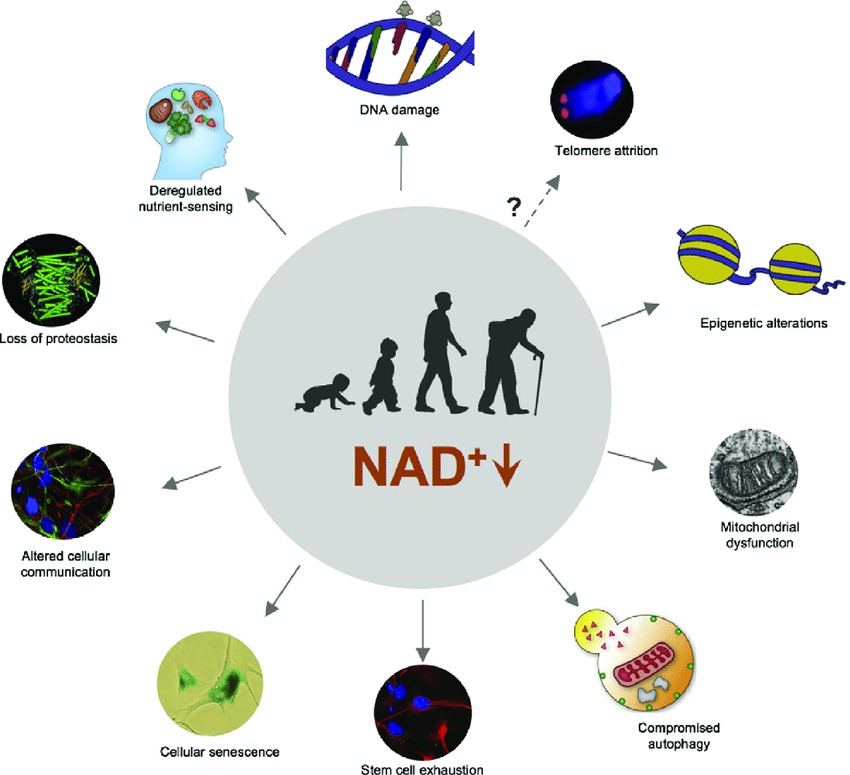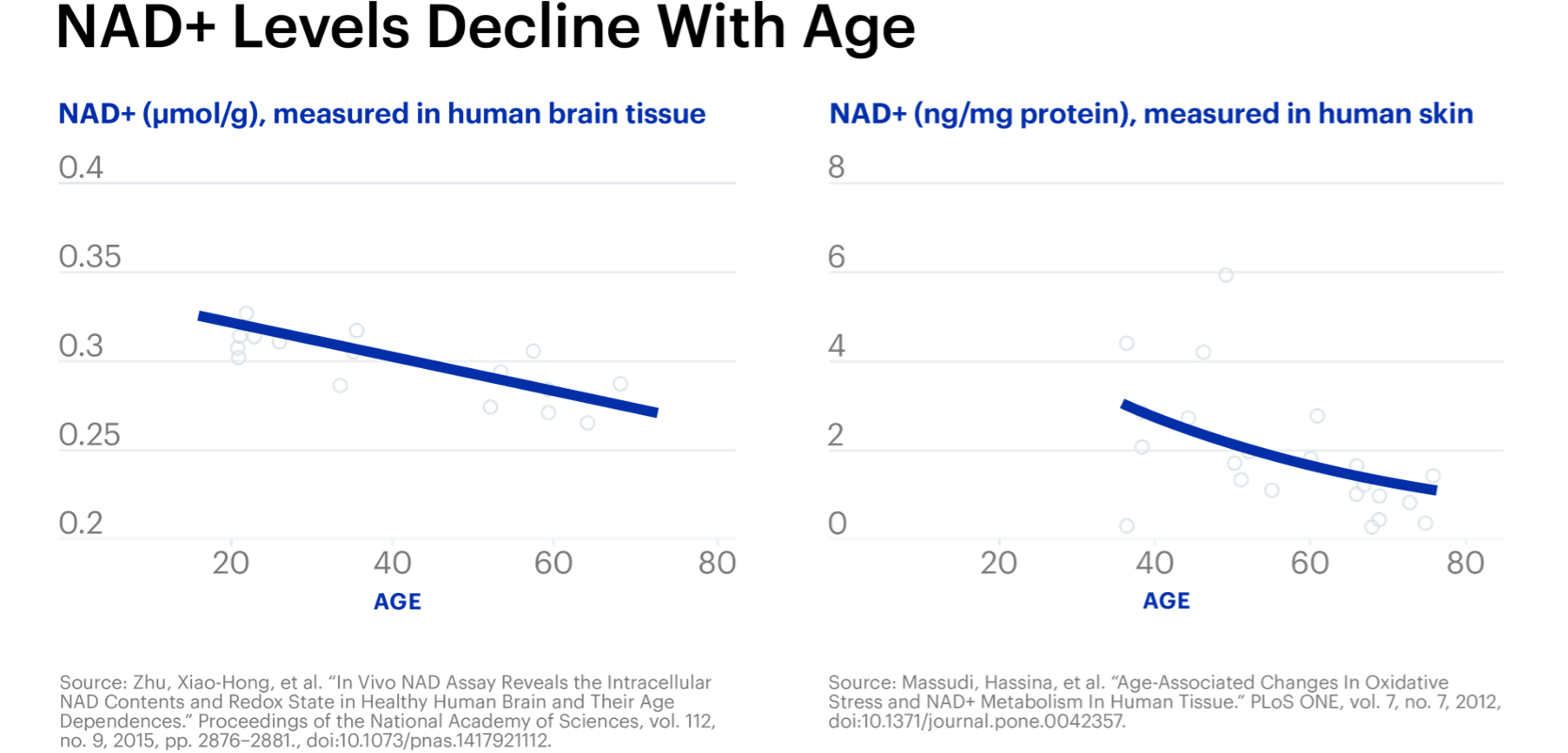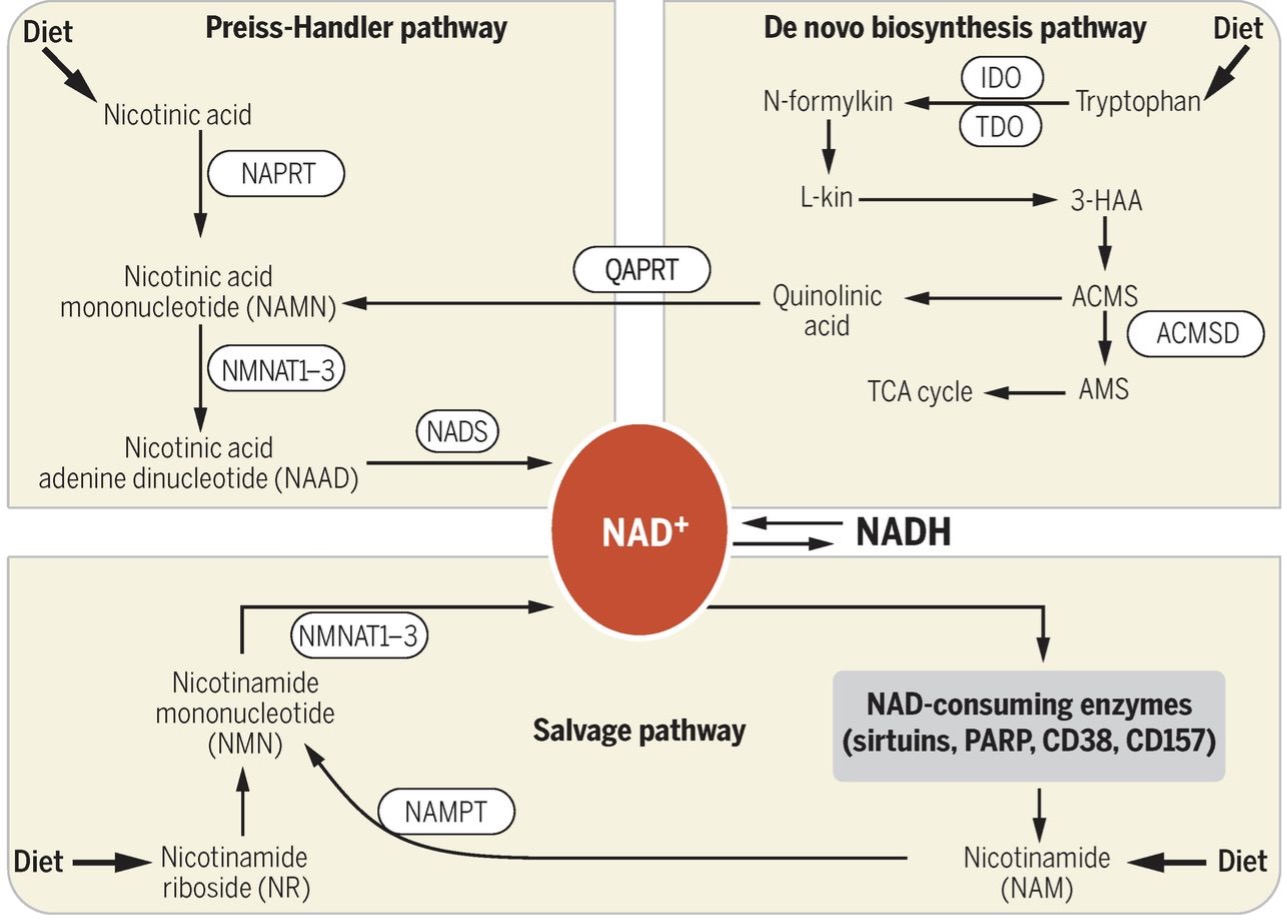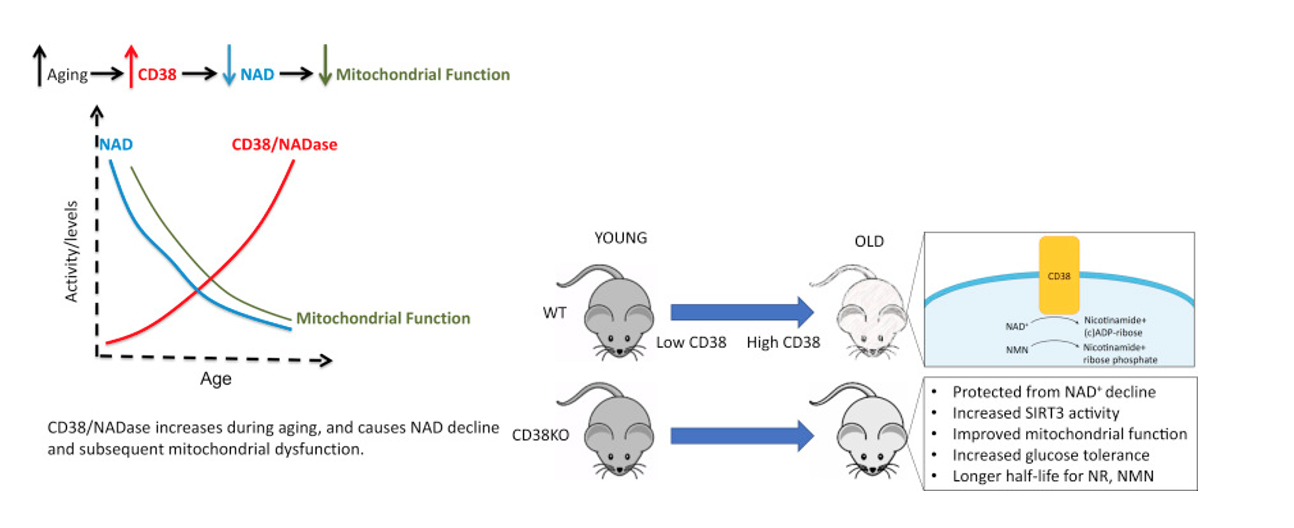NAD or nicotinamide adenine dinucleotide is a derivative of vitamin B3, also known as niacin, niacinamide or nicotinamide (soluble form). NAD is used in over 500 reactions and has a crucial role in metabolism, cellular aging, DNA repair, and gene expression.
NAD intervenes vitally in two very important pathways in humans, namely the sirtuin and PARP pathways. It is essential in functions that influence the aging process, such as mitochondria synthesis, apoptosis, autophagy, inflammation, intracellular and systemic signaling, DNA repair, genomic stability, and programmed cell death.
Dr. Alfonso Galón González – Neolife Medical Team
Without the presence of NAD, much of the reactions that protect us from pathologies related to aging do not occur, we accumulate damage… and eventually we die.
Today I want to share information with you about a very important molecule that we have in our bodies, of which you’ve probably never heard of. It is NAD or nicotinamide adenine dinucleotide, which is a derivative of something that we’re already familiar with, vitamin B3, also known as niacin, niacinamide or nicotinamide (soluble form). NAD is used in over 500 reactions and has a crucial role in metabolism, cellular aging, DNA repair, and gene expression.
Additionally, they intervene vitally in two very important human pathways, which we’ve already mentioned in previous blog posts, namely the sirtuin and PARP pathways.
Sirtuins are a group of 7 enzymes, specifically deacetylase, which are highly preserved from an evolutionary standpoint, from bacteria to humans. They regulate functions that influence the aging process such as mitochondria synthesis, apoptosis, autophagy, inflammation, intracellular and systemic signaling, DNA repair, etc… They’ve been called the genes of longevity.
PARP (Poly-ADP-Ribose polymerase) are a family of polymerase involved in DNA repair, genomic stability, and programmed cell death.
These very important processes I have just mentioned do not occur if there is no NAD, which leads us to accumulate damage, age, and die.
That’s how important NAD is. Additionally, NAD levels drop as we age. In fact, it plays a role in the so called “Hallmarks of aging“.

NAD comes in two forms: NAD+ and NADH. NAD+ accepts electrons from other molecules, becoming NADH, and NADH donates an electron to another molecule, becoming NAD.
Why do its levels decline over the years?

Like most things in our bodies, it’s a balance between production and degradation; in this case, it is simple: not only does the body produce less, but it also degrades more.
As shown in this chart, there are two fundamental synthesis pathways:

The de novo pathway and the salvage pathway.
- The de novo pathway synthesizes NAD from the tryptophan we consume in our diet, but this pathway is not very efficient.
- The salvage pathway effectively uses as precursors recycled parts of the use of NAD as cofactors in various reactions or after it has been used by sirtuins, for example. This is the main pathway of NAD production, but it is limited as we age because of the activity of the enzyme NMPT.
In addition to the decline in its production, as already mentioned, its degradation increases, as well. The previously mentioned PARP increase their activity over the years. This totally makes sense: as we age, DNA damage accumulates, and they must increase their activity to repair it, thus consuming more NAD. And there is another enzyme called CD-38, whose activity doubles or triples as we age, and this directly degrades NAD. In fact, it is believed that the benefit of treatments that seek to combat the inflammation that occurs over the years (inflammaging) comes with the fact that they decrease their activity.
What can we do to keep our NAD levels from declining over the years?
The scientific community is investigating exactly this. It is considering the possibility of increasing de novo synthesis, promoting the salvage pathway, and lowering the activity of enzymes that degrade NAD. Sounds simple, right?
Let’s see what we know so far:
- Increasing de novo synthesis: As already mentioned, this pathway is not very efficient and increasing tryptophan intake does not seem like the best option.
- Promoting the salvage pathway: This can be done in two ways. One, by providing more precursors of the salvage pathway like Nicotinamide (NAM), Nicotinamide Riboside (NR), and Nicotinamide Mononucleotide (NMN), to which we will add what we know about Niacin or Nicotinic Acid (NA), which we may see in the chart for the Preiss-Handler pathway; and two, by increasing the activity of NAMPT.
- Niacin is a great choice. Studies show that it may increase up to 2 times the levels of NAD in 10 months, and it’s affordable. One disadvantage is that extended-release niacin is toxic to our liver, and immediate release niacin may quite often cause what is called the “Niacin Flush”, skin redness accompanied by a greater or lesser degree of itching. However, this is usually the case with the first doses, and then after the body gets used to it, it no longer happens. Moreover, niacin raises our good cholesterol (HDL) level, one of the few treatments to achieve this result. We’ll cover this topic in future blog posts.
- NMN: it’s the most promising. As shown in the chart, it only needs a small reaction to become NAD. The problem is that to this day it is a very expensive supplement, there are no studies that tell us exactly how much NAD levels go up, and there is controversy regarding how it enters the cell.
- NR: It seems that it may double the levels of NAD with a dose of 1 g, but we don’t know if it must be converted into Nicotinamide before becoming NAD or if it does so directly.
- Nicotinamide: This is the soluble form of Vitamin B3. But it’s not without controversy either. It has been shown that when we take it, we inhibit SIRT1 (one of the sirtuins) for 1h, but after 8h it increases its activity. Inhibiting the activity of our sirtuins is the last thing we want, so the way to prevent this from happening is being researched. Additionally, its use and that of any of its derivatives such as NMN, NA, or NR interferes with a very important process called methylation, which is essential for neurotransmitter synthesis, creatine synthesis, choline, and DNA methylation, so whenever we supplement with these precursors, we must add another compound to prevent this interference from happening, usually TMG (trimethylglycine).
- Increasing NAMPT activity. As we have seen, its activity drops over the years, making it difficult to convert Nicotinamide into NMN. What strategies have been shown to increase its activity? Interestingly, but it should come as no surprise, two of the most consolidated, effective, and acclaimed antiaging measures appear here: exercise and nutrition. Aerobic activity has been shown to increase its activity by 12% in young people and 28% in older adults, while strength training increases its activity by 25% and 30% respectively. Calorie restriction (CR) or calorie restriction mimetics, mentioned in these blog posts, have also been shown to increase its activity.
-
The last proposed strategy is to lower the activity of enzymes that consume NAD or degrade it. I think it is clear that we have no interest in lowering the activity of our sirtuins or PARPs. But we may do so in the case of CD-38.

So far we know that a flavonoid present in dry parsley, celery, and chamomile tea, called apigenin, may lower its activity.
I hope that I have been able to convey the vital importance of NAD and maintaining its proper levels. I hope this reinforces your use of good nutrition habits, exercise, and supplementation, as I’ve provided a few more reasons as to why we should exercise, eat well, and use vitamin supplements, as is the case with B3.
BIBLIOGRAPHY
(1) Imai S, Guarente L. NAD+ and sirtuins in aging and disease. Trends Cell Biol. 2014;24(8):464-471. doi:10.1016/j.tcb.2014.04.002
(2) De Flora A, et al. Autocrine and paracrine calcium signaling by the CD38/NAD+/cyclic ADP-ribose system. Ann N Y Acad Sci. 2004;1028:176–191.
(3) Lin S-J, et al. Calorie restriction extends yeast life span by lowering the level of NADH. Genes Dev. 2004;18:12–16.
(4) Imai S, Yoshino J. The importance of NAMPT/NAD/SIRT1 in the systemic regulation of metabolism and ageing. Diabetes Obes Metab. 2013;15(Suppl 3):26–33.
(5) Satoh A, et al. The role of mammalian sirtuins in the regulation of metabolism, aging, and longevity. Handb Exp Pharmacol. 2011;206:125–162.
(6) Lin SJ, et al. Life span extension by calorie restriction in S. cerevisiae requires NAD and SIR2. Science. 2000;289:2126–2128.
